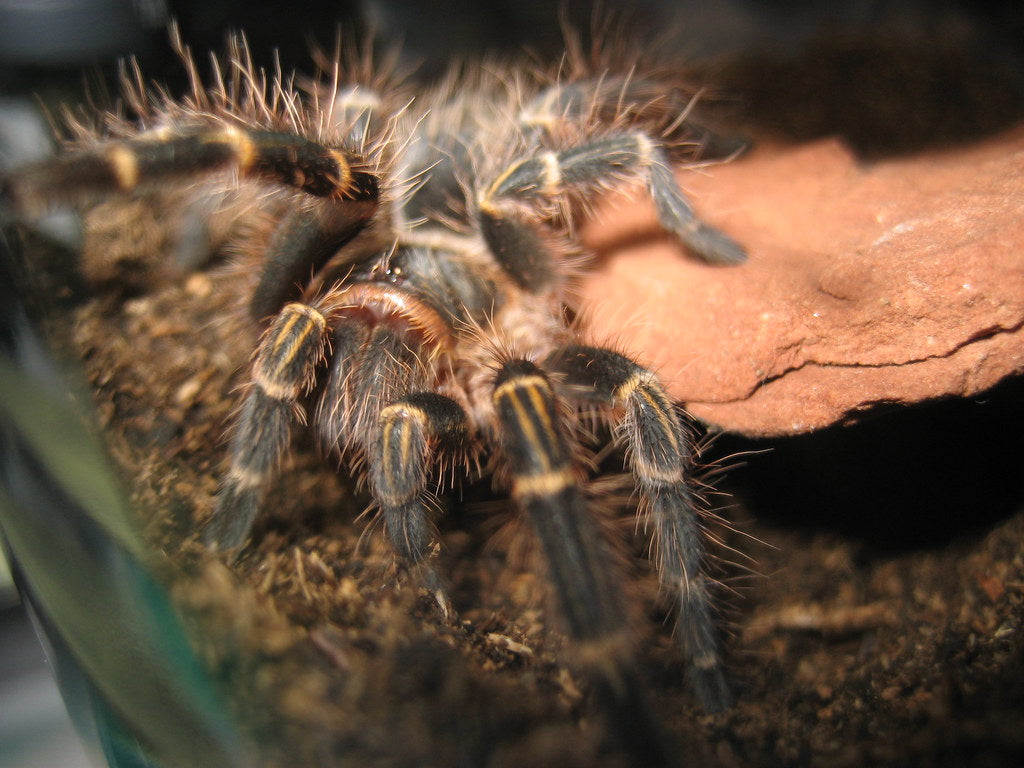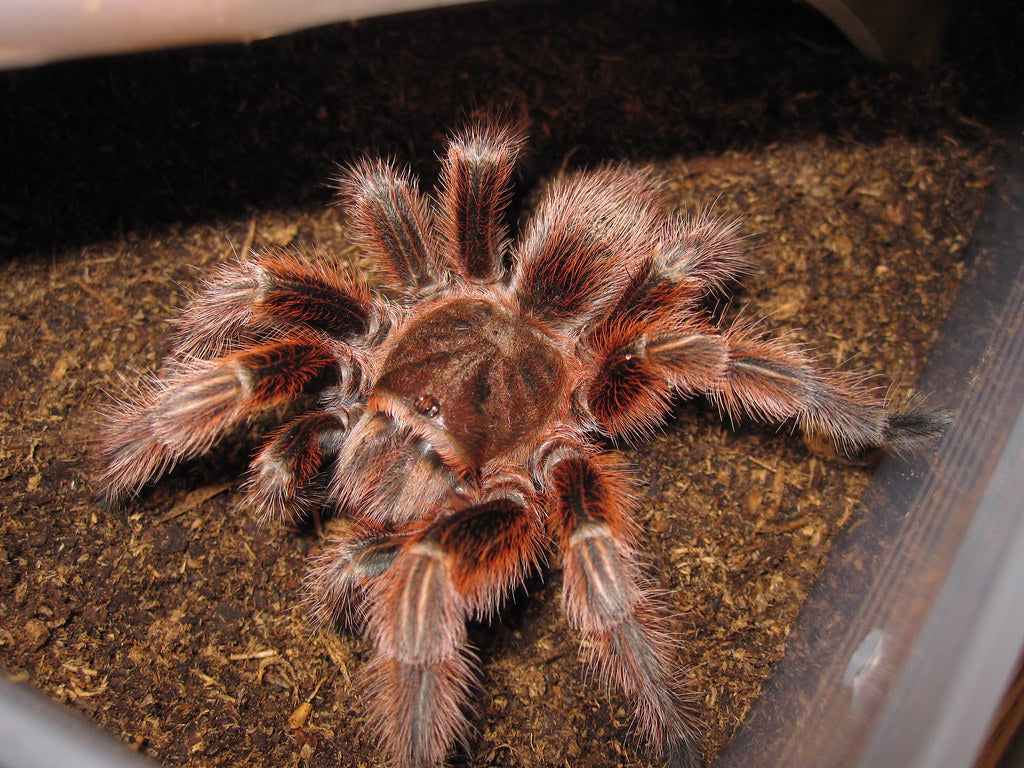The chaco golden knee tarantula (Grammostola pulchripes) is a large, terrestrial tarantula found in Paraguay and Argentina. Their preferred habitat is grasslands with dry winters and wet summers.
Chaco golden knee tarantulas typically have a 7-8” legspan as adults. They have a brown-black base color, with pale joints and golden stripes on their “knee” segments. They are fairly fuzzy, with blond hairs. They do have urticating hairs, but rarely use them. Their venom is not harmful to humans.
Chaco golden knee tarantulas are known for being a great beginner-level tarantula because of their docile dispositions and general hardiness. With good care, males can be expected to live 5-6 years, and females up to 25.
How much space do chaco golden knee tarantulas need?
Chaco golden knee tarantulas don’t need much space, but they do need at least some space for moving around. The minimum for appropriately keeping one adult chaco golden knee tarantula is 20”L x 10”W x 18”H, or the equivalent of a 15-gallon “high” tank. This is just the minimum, so using larger dimensions is beneficial and will happily be used!
It takes about 5 years for chaco golden knee tarantulas to grow from tiny slings to their adult size. It’s best not to house slings in adult-sized enclosures. Instead, basic acrylic spiderling enclosures are usually suitable, no less than four times the spider’s legspan, and no taller than two legspans above the substrate layer.
The enclosure should be well-secured, but not with a mesh lid. Tarantula feet can get stuck in mesh if they climb up that high, which can result in them being stuck upside-down and/or injured. So it’s best to replace the screen with a sheet of acrylic with holes drilled into it for ventilation. Alternatively, you can use a screen lid with holes that are too large for the T’s feet to get stuck, but too small for escape.
Cohabitation (keeping multiple tarantulas in one enclosure) is not recommended, as cannibalism is possible.
Do chaco golden knee tarantulas need UVB?
They can certainly survive without it, and due to this fact, as well as the fact that UVB wavelengths are blocked by glass and acrylic lids, UVB is not commonly used among tarantula keepers.
That being said, there is some evidence to suggest that tarantulas may benefit from UVB lighting when appropriately provided. This paper speculates that wild tarantulas may get at least part of their vitamin D3 from UVB exposure, and this paper provides evidence of invertebrates being able to synthesize vitamin D3 from UVB.
If you wish to provide UVB to your tarantula, the best UVB bulb to use is likely to be the compact coil Zoo Med Reptisun 5.0, 13w. The bulb should be mounted horizontally in a reflective fixture, and placed on top of a mesh lid with holes large enough to prevent the tarantula’s legs from getting caught. (For this reason, it may be best to refrain from providing UVB lighting until your tarantula is large enough for an adult-sized enclosure.) UVB bulb output decays over time, so make sure to replace your bulb every 6 months.
Lights should be on for 12 hours/day.
What temperatures do chaco golden knee tarantulas need?
Tarantulas are ectotherms, which means that they need to be kept within a specific range of temperatures in order to regulate their metabolism and stay healthy.
Chaco golden knee tarantulas specifically should be kept at temperatures no lower than 68°F and no higher than 78°F. Room temperature should fall within this range, making additional heating unnecessary. However, if your room gets cooler than this range, then you’ll need a heat source. A small heat mat, stuck to the side of the enclosure and regulated with a thermostat, should be enough to address this problem. Track the temperatures in your enclosure a digital probe thermometer.
What humidity levels do chaco golden knee tarantulas need?
Chaco golden knee tarantulas’ humidity needs change as they age. When they’re young, it’s best to keep their substrate slightly moist, but not swampy or saturated. As adults, however, they do best with drier substrate. Inside a larger enclosure, you can keep one half of the substrate moistened and one half dry so the tarantula can choose as needed.
What substrate is good for chaco golden knee tarantulas?
Chaco golden knee tarantulas like to burrow, especially when they’re young. So it’s important to give them a thick layer of substrate that they can dig in and move around. Substrate should be at least 2” for slings, and 5” for the adult enclosure.
We recommend the following substrates for chaco golden knee tarantulas:
What décor can you use in a chaco golden knee tarantula terrarium?
Tarantulas may not seem to do much, but it’s still beneficial to give them items in their enclosure that they can explore and use to express natural behaviors. It also makes the enclosure more attractive!
At minimum, your tarantula needs at least one place to hide. However, additional options include:
- low branches
- cork flats
- live or artificial plants
- artificial ornaments
What do chaco golden knee tarantulas eat?
Tarantulas are carnivores, which means that they need whole prey in order to get the nutrition that they need. Here is a basic feeding schedule:
- Slings under 1/2" — 1-2x/week
- Juveniles — 1x/week
- Adults — every 7-14 days
Tarantulas really don’t need to eat much. 1-3 appropriately-sized insects per feeding is plenty, and adjust the quantity based on the size of the spider’s abdomen. Prey insects should be small enough for the tarantula to overpower, which is an especially important consideration for slings. Live, well-gutloaded prey is a requirement.
Offer a variety of different insects if possible to provide varied nutrition:
- Black crickets
- Black soldier fly larvae
- Brown crickets
- Dubia roaches
- Discoid roaches
- Flightless fruit flies (for slings)
- Mealworms
- Red runner roaches
Water
Tarantulas under 2” across should receive water via routine misting of the enclosure. The enclosure should be allowed to dry between mistings. Tarantulas over 2” may have a shallow water dish for drinking. Change the water daily and scrub the bowl with a reptile-safe disinfectant weekly.
Do chaco golden knee tarantulas like to be handled?
As a general rule, it’s best not to handle tarantulas. But as far as tarantulas go, chaco golden knees tolerate occasional handling very well. They rarely bite, shoot hairs, or even offer a defensive posture. When allowed to crawl onto your hand of their own volition and handled gently, they can be an ideal tarantula for a keeper who prefers to be a little more “hands-on” with their pets.
*This care sheet contains only very basic information. Although it’s a good introduction, please do further research with high-quality sources to obtain additional information on caring for this species.
"Grammostola pulchripes tarantula" by Tarantuland is licensed under CC BY-NC 2.0



Leave a comment
This site is protected by hCaptcha and the hCaptcha Privacy Policy and Terms of Service apply.